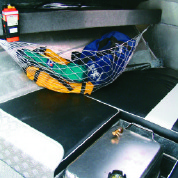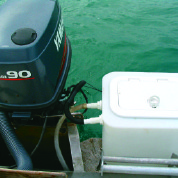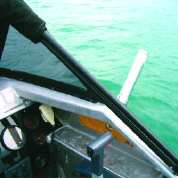When the Gamefishing bug struck Shane Kelly, he had no idea of the learning curve ahead. In this article he recalls how the 5.6m boat became a gamefishing vessel.

Was that a large blue angel bastard you wanted … no lure collection is complete without a lumo sprocket … how about this evil Hawaiian bagwan? I was in over my head, no doubt about it. I was trying to buy gamefishing lures and the guy behind the counter was talking Swahili to me. That’s fine in Swahililand, but it’s not what you expect from a respectable fishing stockist in Westhaven. So I chose what I thought looked good – thereby proving one of gamefishing’s “lores” that the first job of the lure, even before it gets to catch fish, is to hook the fisherman.
Fishing had always been simple before, but my wife had utterly changed that by buying me a gamefishing video called Blue Water for Christmas. Me and my fishing buddy John had toyed with some gamefishing – trolling lures for tuna – but we weren’t really serious until I watched that video. It wasn’t footage of catching big fish, it was farrrr more seductive than that, it was and educational effort by one of Northland’s most knowledgeable deckies -a bloke called Matt Watson – and he was giving away years of his gamefishing secrets. Something gelled inside and I went from being largely disinterested in gamefishing to being hooked, gaffed and tagged – but not released. It only took five viewings of that video. This article describes the way I approached it. I don’t hold myself out to be an expert, I’m just recalling the process and some of the decisions we had to make in the quest to catch a gamefish from our modest little boat. The family Ramco 560, Bender, wasn’t the ideal platform to turn into a gameboat. Designed as an all round family fishing, skiing, sea biscuiting and picnicking boat, it had nonetheless put in plenty of rugged fishing miles for us, so we had great confidence in it and the Yamaha 90 outboard had been ultra reliable. Besides, Bender was all I had, so I convinced myself that catching a marlin out of the boat was possible. While catching marlin was the plan, catch 22 became the order of the day once I had decided to go for the doctor. To decide on the gear to buy, then settle on the layout and fitting of gear, we first had to understand the techniques and styles of fishing, and then make decisions about the ones we intended to use. There were a lot of decisions to make and every step would be technical and important to get right.
In my case they would be based on almost no practical
experience. There was no sense in spending the thick end of $5000 only to find the layout I had chosen was unworkable, or that I’d used the wrong crimp and have a marlin leap away –even worse, potentially leaving a hook embedded in it. I soon became indebted to the members of the New Zealand fishing website, www.fishing.net.nz, for their assistance and detailed advice.

No matter what the topic or query, I could ask for advice on the forums and count on help freely given from a number of highly experienced people. One even generously gave me a set of lures. I asked advice on outriggers, placement, on lure selection, on live baiting and skip baiting, on the type of gear, line weights and terminal tackle, hooks, sharpening, downrigging, trolling speed and many others. The advice and assistance I was generously given would have taken years and years on the water to amass. When you add in the good humour and the discussion on all types of fishing, picking peoples’ brains on the site was also extremely entertaining. Progress was limited by both finance and wanting to spend the money the right way, so as we progressed we took gamefishing trips to check on our progress and the decisions we had made on gear and fitting. These are also recalled, trip by trip, starting with the first memorable occasion….
Houhora

April 2002. An easy trail through the night on Thursday is one advantage of having a 5.6m boat. Early Friday morning found us out off Houhora in stunning conditions, flat calm seas in that delightful azure blue water brought in by the warm currents. Gamefish territory. We ran about 10 miles North East of Houhora harbour and saw the only gamefish of the weekend when a yellowfin broke the surface about 50 metres in front of the boat.
Bender was instantly like a Marx Brothers movie on fast forward. The tuna gear had only ever been set in my imagination … until that moment it had never been tried in anger. Fortunately it all worked as I had envisaged, but was completely ineffectual. The cold hard reality of inexperience hit home. We weren’t being overly serious and the set up was basic –we ran smallish tuna lures on 12 and 15kg outfits set in the normal rod holders. We had no way to land a decent size fish – a snapper gaff being the only one we carried, so we hoped that no 100kg+ marlin took a fancy to our lures. We motored and trolled for about 90 nautical miles that day and at one stage were looking back at North Cape from 25 miles out to sea. The ocean seemed pretty dead, with no tailing marlin, no birds and no workups, although we found some tiny baitfish in a state of excitement at one stage. In the late afternoon we had a successful snapper fish tucked under the North Cape light before pounding our way back to Houhora, about 25 nm, through a rising NNE wind. Arriving at Houhora we had about 10 litres of fuel left, which was a bit close for comfort. Plenty of range is one of the prerequisites and the way the boat uses gas when trolling at 6-9 knots seems alarming. For our first big gamefish at Houhora we had bought an extra 25 litre tote tank, taking the total we carried to 120 litres. While Houhora proved we had range of around 100 nautical miles using the 70 litre under floor and two 25 litre totes, there was little in reserve and not enough if the weather cut up rough, when fuel consumption rises considerably. For this season we have since added a 42 litre stainless tote that should give us sufficient range for all eventualities while leaving around 20 litres in hand.
Choosing the gear so as to cause a divorce
Outriggers
For the Houhora trip we tried putting the rods in bent stainless pipes in the rod holders, but this set-up kept the rod tips too low, it meant we had to lean well outboard to retrieve the rods and the reels ended up with waves constantly washing over them. I decided we needed proper outriggers, a decision backed up by the experts. There are a number of excellent outriggers suitable for small boats. Each brand seems to have its own bending characteristics and I could not get a consensus about how much flexibility is desirable. We soon learned that in gamefishing, there is no one clear cut way to do anything and I suspect that everyone just buys outriggers and puts up with them.
We chose telescoping alloy outriggers called Tel-o-Riggers on the basis that I didn’t know what the hell to do with two 15ft long fibreglass poles for the nine months of the year when we wouldn’t be using them. The Tel-o-Riggers telescope down to a little over a metre long, extend to between four and five metres and seem to have a nice mix of stiffness and flexibilit y. The truth on how good they are will be told when, one day next year, one of the riggers snaps backwards, the clip lets go and adrenaline floods our system as one of the reels begins unloading line at a kajillion miles an hour.

The only place the riggers could be mounted was on the sides of the cuddy adjacent to the helm and passenger seat. The mounting is an unobtrusive metal plate a bit smaller than a cigarette packet and we chose to strengthen the inside against the wracking forces imposed by the bending riggers, firstly with a piece of plastic (which wasn’t really stiff enough) and this year, by a piece of plywood on the inside of the cuddy side. A four inch cleat was also fastened to each side of the boat for tensioning the clip halyards. The fitting of the outriggers didn’t go without a little family drama … well, drama for someone else’s family actually. Not wanting the Chief Executive Officer to see that I’d spent $500 of the housekeeping money on kit for the boat, I figured I could get the small mounting plates on (which I reckoned she wouldn’t notice) and keep the telescoped riggers well hidden until we were out fishing. The problem came when, to get the right placement for the halyard cleats, I needed the outriggers extended and rigged in all their glory. So I concocted a story about needing assistance with the boat from my long-suffering fishing buddy, John Mac. At the other end he did the same, planning to meet me at a boat ramp where we could set everything up … except he got into serious strife with his CEO for not inviting my family to spend time with his family. Apparently not doing so meant he was guilty of several antisocial and other certifiable faults. Before my duplicity cost him his marriage, I gave in, fessed up and took the personal hit (generally speaking, that means a purchase of equivalent value for her.)
Rod holders
Fortunately we had plenty of rod holders on the boat – plastic ones can bind up when there’s a fish on, making the rod impossible to get out until the fish has either spooled you or busted the line. The six stainless steel ones had been fitted by Hugh Stewart from Yamaha NZ, who with typical generosity four years ago, offered to put the rod holders in for me. The deal was that I had to provide him with good quality stainless ones – that was just one of the pieces of advice he gave me in the early days that I have thanked him for countless times. Spend the money on good gear up front and you’ll save it in the long term. Like the expensive fuel filter he insisted be fitted which saved the outboard powerhead within the first six months!
I also needed a series of fittings for rod safety tethers – one per rod holder. These were about the only fittings I pop-riveted, all the rest were through bolted with washers behind (and also using plastic insulators supplied by Ramco to prevent electrolysis between the alloy and the bolts.)
Rods
We started out with two Penn Formula 15s and a couple of 10kg-sized kingfish reels. We soon realised that we were under gunned and the last thing I want is to send a marlin off with hundreds of metres of nylon dragging behind because we couldn’t stop the fish. So as the funds allowed we upped the ante, adding two Penn Formula 24s and a pair of Penn 50VSW internationals. Both are spooled with 24kg, with the Formula 24s having a supplementary “backstop,” 200m of braid at the bottom of the nylon. A major decision was whether to use monofilament or Dacron line, with a lot of people recommending Dacron for its resilience. But while it makes a lot of sense for charter boats and the hammering their gear takes, we couldn’t justify the extra expense and the fact that I would need to learn a whole new way of rigging lines. I decided to stay with monofilament.
Autopilot
One excellent idea I pinched off a mate’s boat was a simple arrangement for steering while setting up the gear. There are only two of us, so the helmsman has to leave the wheel to assist with deploying the gear, and hopefully, clearing it when we get a strike. The “autopilot” comprises a piece of cord that loops around the steering wheel and jams into a small yacht cam cleat. This holds the wheel and keeps the boat heading in a (relatively) straight line while setting out lures – otherwise the boat just turns with the engine torque and you end up with a cat’s nest of nylon at 90 degrees to the transom. It won’t steer the boat unattended for long periods of time because waves and people moving around in the boat tend to knock it off course, but it’s real handy and cost less than $10 in a situation where a true autopilot would be unrealistic.




